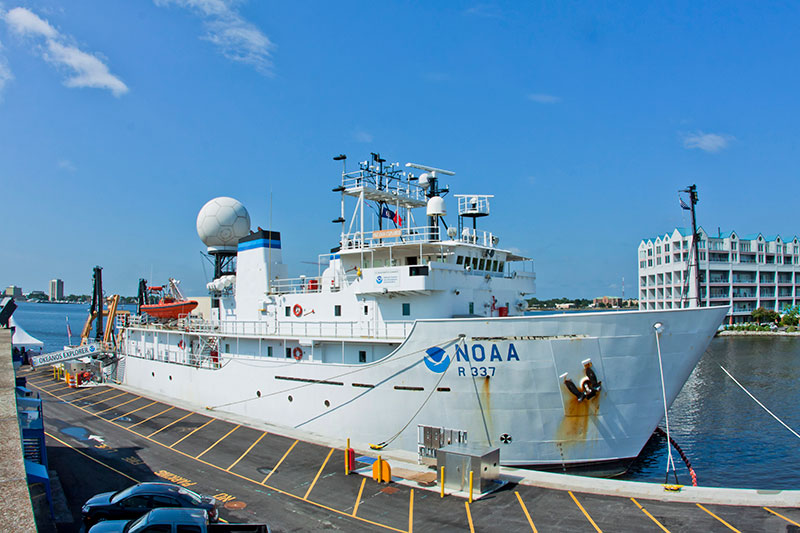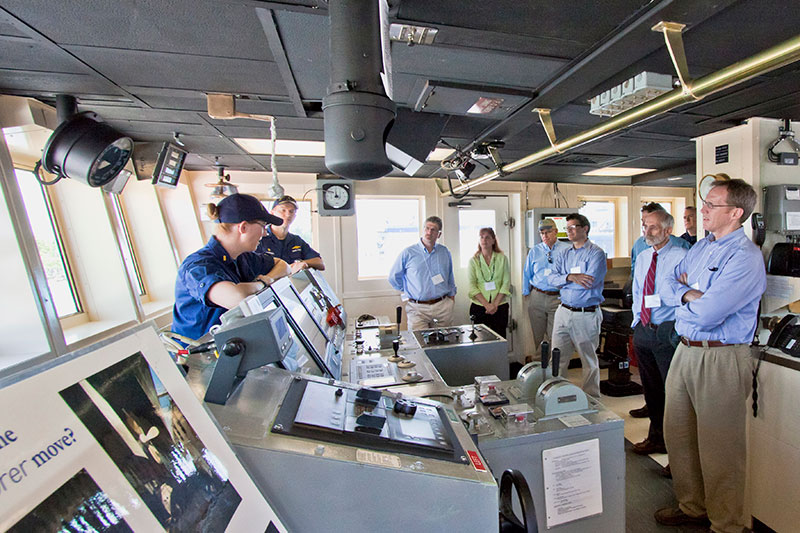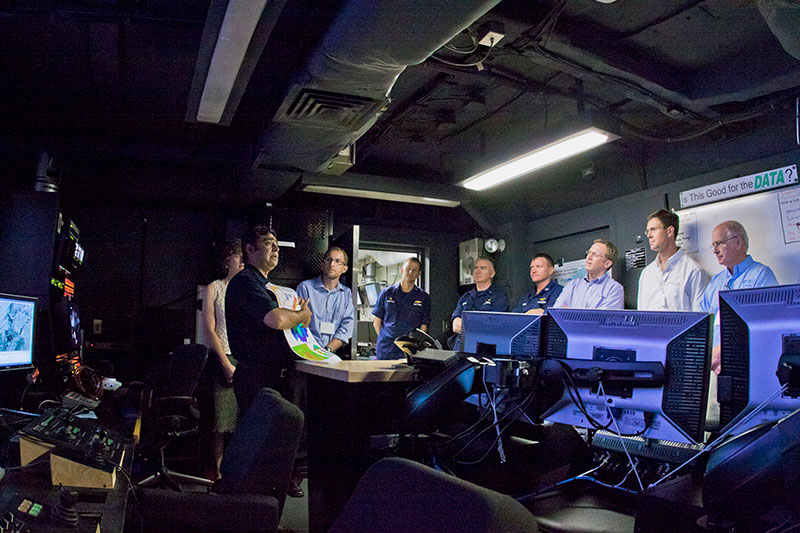
by Janet Krenn, Virginia Sea Grant

NOAA Ship Okeanos Explorer is docked in Norfolk awaiting a June 2012 cruise to map the mid-Atlantic's deepwater canyons. The ship is one of four NOAA vessels conducting complementary science operations on Atlantic undersea canyons in 2012. Image courtesy of the NOAA Office of Ocean Exploration and Research. Download larger version (jpg, 1.7 MB).
To the landlubber, the ocean floor may seem remote. For scientists and resource managers, however, the deep sea is of great ecological, economic, and scientific importance. Deep-water canyons provide a refuge for a variety of animals, including deep-sea corals and fish. Knowing how ecologically and commercially important fish use the canyons can improve the way we manage fisheries. Deep-water environments can also be sources for offshore energy or have other uses. Deep-sea maps are essential to better understand and manage these areas.
Data and information about deep waters are so important that representatives from 15 federal and state organizations are following the successes of the Atlantic Canyons Undersea Mapping Expeditions (ACUMEN) project. This federal-state collaboration is putting usually difficult and expensive to obtain data about the seafloor directly into the hands of state management agencies and regional organizations.

NOAA Corps officers on NOAA Ship Okeanos Explorer discuss operations with federal and state scientists and managers. Image courtesy of Jenet Krenn, Virginia Sea Grant and the NOAA Office of Ocean Exploration and Research. Download larger version (jpg, 2.1 MB).
Studying anything underwater is very difficult, and canyons pose additional challenges. Fortunately, the ACUMEN federal-state partnership will provide a more coherent understanding of these poorly understood areas by capitalizing on the complementary capabilities of four NOAA ships: Okeanos Explorer, Ferdinand R. Hassler, Henry B. Bigelow, and Nancy Foster.
While Okeanos Explorer specializes in mapping areas deeper than 500 meters, Hassler is designed to survey shallower areas. Scientists will use the combined mapping data from those two ships to identify locations for Bigelow to investigate with a towed camera system. Nancy Foster is part of a joint NOAA and Bureau of Ocean Energy Management project doing similar work in other undersea canyons to the south of ACUMEN areas of operation.

Mashkoor Malik discusses the various types of data that are being collected by various NOAA ships as part of the Atlantic Canyons Undersea Mapping Expeditions (ACUMEN) project. Image courtesy of Jenet Krenn, Virginia Sea Grant. Download larger version (jpg, 5.5 MB).
Getting these data off the ships and into the hands of local and regional groups can be as complicated as collecting the data. Typically, local groups lack a clear way to get involved with federal agencies such as NOAA that gather such data.
“This is the advantage of working with existing state-federal partnerships, like Sea Grant,” says Troy Hartley. Hartley, the Virginia Sea Grant Director, played the role of matchmaker, bringing together NOAA staff with potential local and regional partners. By making contact in advance of this season’s upcoming cruises, NOAA was able to better understand local needs, even adding mapping targets based on suggestions made by local groups.
Laura McKay, Manager of the Virginia Coastal Zone Management Program and member of the Mid-Atlantic Regional Council on the Ocean (MARCO) Management Board, two organizations that will benefit from the data gathered this summer, says the new partnership is very exciting.
“This is the first time I’ve seen real connections and involvement between state coastal managers and what federal agencies like NOAA and the Bureau of Ocean Energy Management can do out there on the continental shelf and slope,” she said. “This is a great opportunity for states to become stronger stewards of ocean health and to help ensure its sustainable use.”
The data McKay’s groups receive will be added to MARCO’s online map of ocean resources and uses.
For Eric Schwaab, Deputy Administrator of NOAA, this kind of collaboration fits perfectly into NOAA’s Habitat Blueprint vision of ocean management: To gather data to inform better decisions about conservation and use of ocean resources and facilitate partnerships between data users and gatherers.
“If we do a better job of coming together, planning together, and working together, data from projects like these can lead to better conservation and more profitable uses of our resources over the long term,” Schwaab said.